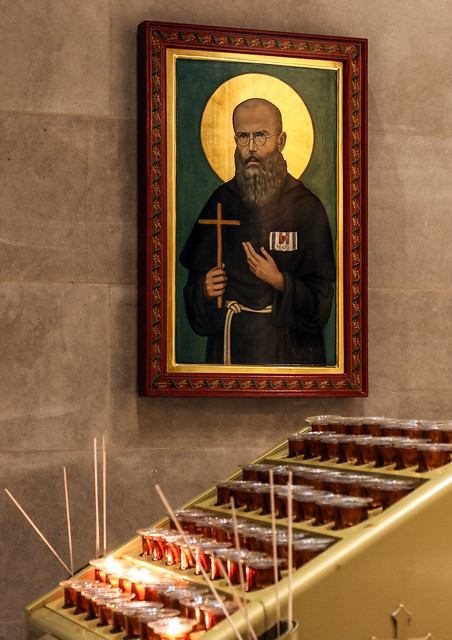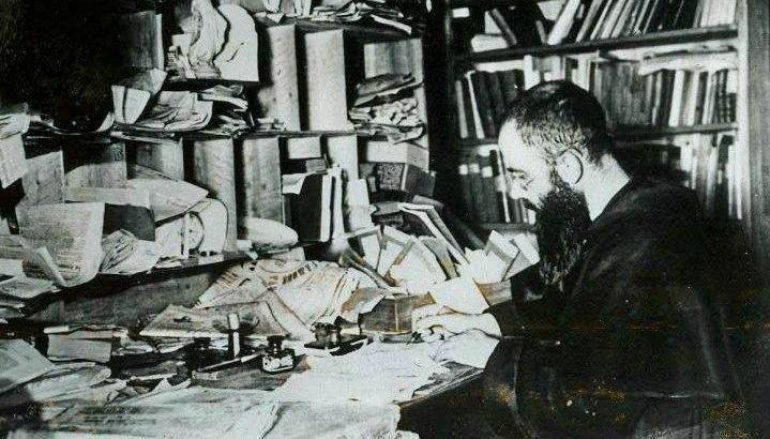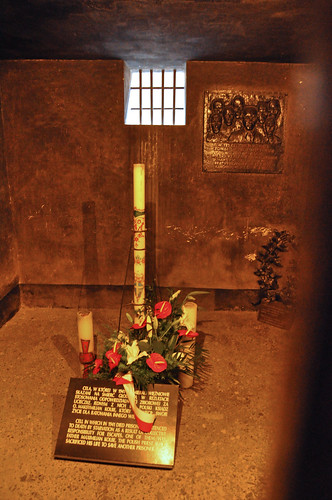
Father Lawrence Lew, OP via Flickr, licensed cc
Who was St. Maximilian Kolbe?
St. Maximilian Kolbe was born on January 8, 1894, in the Kingdom of Poland, part of the Russian Empire. His birth name was Raymond. Always a devout child, he had a vision of the Blessed Mother starting at age 12.
“That night I asked the Mother of God what was to become of me. Then she came to me holding two crowns, one white, the other red. She asked me if I was willing to accept either of these crowns. The white one meant I should persevere in purity and the red that I should become a martyr. I said that I would accept them both.”
Kolbe was interested in the priesthood and also a military career. Eventually, he entered the priesthood and was ordained in 1918.
He still went to war of a sort – fighting to spread the gospel and his faith. He founded the Militia Immaculata in 1917. He wrote articles in a monthly magazine with a huge subscription to encourage conservation through Mary.
It is very fitting that his feast day appears just before a big Marian Feast day tomorrow.

Clearly, Father Kolbe was not the patron of an orderly desk – and I can totally relate!!
World War II
Maximilian Kolbe was arrested rested with several of his brothers on September 19, 1939 following the Nazi invasion of Poland, and released on December 8, 1939. Once back in Niepokalanow he continued his priestly ministry, The brothers housed 3,000 Polish refugees, two-thirds of whom were Jewish, and continued their publication work, including materials considered anti-Nazi. For this work the presses were shut down, the congregation suppressed, and the brothers dispersed. Maximilian was imprisoned in Pawiak prison, Warsaw, Poland on February 17, 1941.
Life in Auschwitz
On 28 May 1941, he was transferred to Auschwitz and branded as prisoner 16670. He was assigned to a particular work group staffed by priests and supervised by especially vicious and abusive guards. His calm dedication to the faith brought him the worst jobs available, and more beatings than anyone else. At one point he was beaten, lashed, and left for dead. The prisoners managed to smuggle him into the camp hospital where he spent his recovery time hearing confessions. When he returned to the camp, Maximilian ministered to other prisoners, including conducting Mass and delivering communion using smuggled bread and wine.
In July 1941 there was an escape from the camp. Camp protocol, designed to make the prisoners guard each other, required that ten men be slaughtered in retribution for each escaped prisoner. Francis Gajowniczek, a married man with young children was chosen to die for the escape. Maximilian volunteered to take his place.
He encouraged the others with him and led prayers to Our Lady. The prisoners with him died of starvation and Maximilian Kolbe survived. He was finally given a lethal injection. It is said that he raised his left arm and calmly waited to die. He died as he had lived -in service to others.
He is the patron saint of prisoners and people that are afflicted with addiction. Today, his cell at Auschwitz, Cell 18, is a destination for pilgrims as a place to visit and pray.

Jennifer Boyer, via Flickr, licensed cc.
The sign says: Cell in which in 1941 died prisoners sentenced to death by starvation as a result of collective responsibility for escapes. one of them was Father Maximilian Kolbe, the Polish priest who sacrificed his life to save another prisoner.
More from the Catholic Culture Site
Saint of the Day
Kolbe quotes
Esther, A Catholic Mom in Hawaii has lots of information on this important saint.


